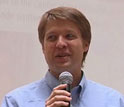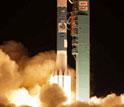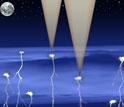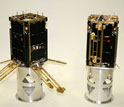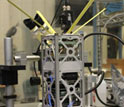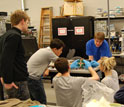Media Advisory 12-015
Cubesats "Land" at National Science Foundation on Thursday, May 24th
Scientists, engineers, educators from cubesat projects will showcase their projects at NSF headquarters in Arlington, Virginia
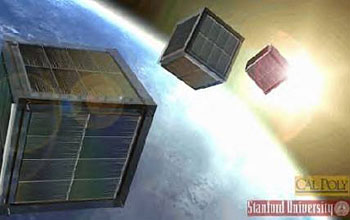
NSF-funded cubesats: ultra-small satellites for space weather and atmospheric research.
May 11, 2012
View a webcast showing presentations by cubesat scientists, engineers and educators.
This material is available primarily for archival purposes. Telephone numbers or other contact information may be out of date; please see current contact information at media contacts.
Imagine a fully instrumented satellite the size of a half-gallon milk carton.
Small low-cost satellite payloads, built mainly by students and hitching rides into orbit on Air Force and NASA launch vehicles, have been making recent history in successes many herald as a "space revolution."
Called cubesats for the roughly four-inch-cubed dimensions of their basic building elements, each one is stacked with modern, smart-phone-like electronics and tiny scientific instruments.
Several cubesat projects funded by the National Science Foundation (NSF) are currently operating in orbit, making first-of-their-kind experiments in space and providing new measurements that help scientists understand how the Earth's upper atmosphere responds to solar activity.
And more are on the way.
Several other payloads are already built and awaiting launch this summer with their host spacecraft. Yet others are in the process of being constructed or designed, all poised to provide new scientific measurements to answer questions in space and atmospheric science.
But this is just the beginning, say scientists.
The future of cubesat projects is only limited by the imagination, researchers believe. The capabilities of cubesat systems are growing at an ever-increasing rate as technological advances are made.
Opportunities are many to accelerate this technology through engineering research in an array of fields, including materials research, 3-D printing, sensor miniaturization, micro-electro-mechanical systems, systems engineering, radio science, communication algorithms and networks.
Private firms and government agencies are also adopting the cubesat concept as a low-cost way of flying payloads in space while creating important educational opportunities for future leaders of industry.
The projects stimulate widespread excitement and involve a unique set of skills and interests. They appeal, say researchers, to a broader range of participants than more traditional science and engineering projects.
What will it take for future cubesat projects to provide the crucial measurements from space needed to solve critical societal problems, such as climate change, land use and resource management, pollution and disaster monitoring, communication and space weather?
On May 24, NSF will host an event titled: "Workshop to Explore the Utility of Cubesat Projects for Scientific Research and Technology Advances and STEM Education and Workforce Development."
Scientists, engineers and educators will showcase their current NSF-funded cubesat science and engineering projects.
Presentations will explore the potential for cubesat projects to play a major role in solving critical societal problems and enabling scientific discoveries and engineering innovation.
The event will feature posters and exhibits presented by the project teams, as well as presentations highlighting current and future cubesat capabilities.
| Who: | Cubesat project scientists, engineers, educators and students |
| What: | Workshop to Explore the Utility of Cubesat Projects for Scientific Research and Technology Advances, and STEM Education and Workforce Development |
| When: | Thursday, May 24, 2012, noon to 3:00 p.m. ET |
| Where: | National Science Foundation Atrium, 4201 Wilson Blvd., Arlington, VA 22230 |
Detailed Agenda:
Organizers:
- Therese Moretto Jorgensen, NSF program director for Space Weather Research and Instrumentation in the Geosciences Division of Atmospheric and Geospace Sciences
- Rathindra DasGupta, NSF program director for Industry/University Cooperative Research Centers in the Engineering Division of Industrial Innovation and Partnerships
- Kevin Simmons, Senior Policy Analyst in the Engineering Division of Industrial Innovation and Partnerships
Schedule:
Noon to 3 p.m.--Posters and exhibits are staffed
1 p.m to 3 p.m.--Presentations:
- Michael Morgan, NSF Division Director for Atmospheric and Geospace Sciences--Welcome and introduction
- Jordi Puig-Suari, California Polytechnic (to be confirmed)--Cubesats as a disruptive technology
- James Cutler, University of Michigan--Experiences with student-built cubesats
- Norman Fitz-Coy, University of Florida--Utility of cubesat data to developing countries, especially those in Africa, for addressing socio-economic needs
- Eloisa de Castro, Princeton Satellite Systems, Inc.--Industry involvement in cubesats and education.
-NSF-
-
View Video
Imagine a fully instrumented satellite the size of a half-gallon milk carton: a cubesat.
Credit and Larger Version -
Launch of a rocket on October 28, 2011, that carried the NSF RAX and DICE cubesats.
Credit and Larger Version -
The 'firefly' cubesat mission studied lightning and gamma rays in thunderstorms.
Credit and Larger Version -
Two completed cubesats at Utah State University in the DICE cubesat project.
Credit and Larger Version -
Researchers at the University of Michigan work on the RAX cubesat project.
Credit and Larger Version -
The scientific team during final assembly of the RAX cubesat.
Credit and Larger Version
Media Contacts
Cheryl Dybas, NSF, (703) 292-7734, email: cdybas@nsf.gov
Related Websites
National Science Foundation Awards Grant to Build "CubeSats": http://www.nsf.gov/news/news_summ.jsp?cntn_id=112341
Small Satellite Takes on Large Thunderstorms: http://www.nsf.gov/news/news_summ.jsp?cntn_id=112591
The U.S. National Science Foundation propels the nation forward by advancing fundamental research in all fields of science and engineering. NSF supports research and people by providing facilities, instruments and funding to support their ingenuity and sustain the U.S. as a global leader in research and innovation. With a fiscal year 2023 budget of $9.5 billion, NSF funds reach all 50 states through grants to nearly 2,000 colleges, universities and institutions. Each year, NSF receives more than 40,000 competitive proposals and makes about 11,000 new awards. Those awards include support for cooperative research with industry, Arctic and Antarctic research and operations, and U.S. participation in international scientific efforts.
Connect with us online
NSF website: nsf.gov
NSF News: nsf.gov/news
For News Media: nsf.gov/news/newsroom
Statistics: nsf.gov/statistics/
Awards database: nsf.gov/awardsearch/
Follow us on social
Twitter: twitter.com/NSF
Facebook: facebook.com/US.NSF
Instagram: instagram.com/nsfgov



